Get PeakVisor App
Sign In
Search by GPS coordinates
- Latitude
- ° ' ''
- Longitude
- ° ' ''
- Units of Length

Yes
Cancel
Share ×

Scan the QR code and open PeakVisor on your phone
❤ Wishlist ×
Choose
Delete
Known for its emerald lined bamboo woods, Basianshan National Forest Recreation Area (八仙山國家森林遊樂區) is home to ethereal forests that are located in central Taiwan. The verdant woodlands in the recreation area contain 10 named mountains, the highest and most prominent of which is Jiuxian Shan (九仙山) at 2,986 meters (9,797 ft) in elevation.
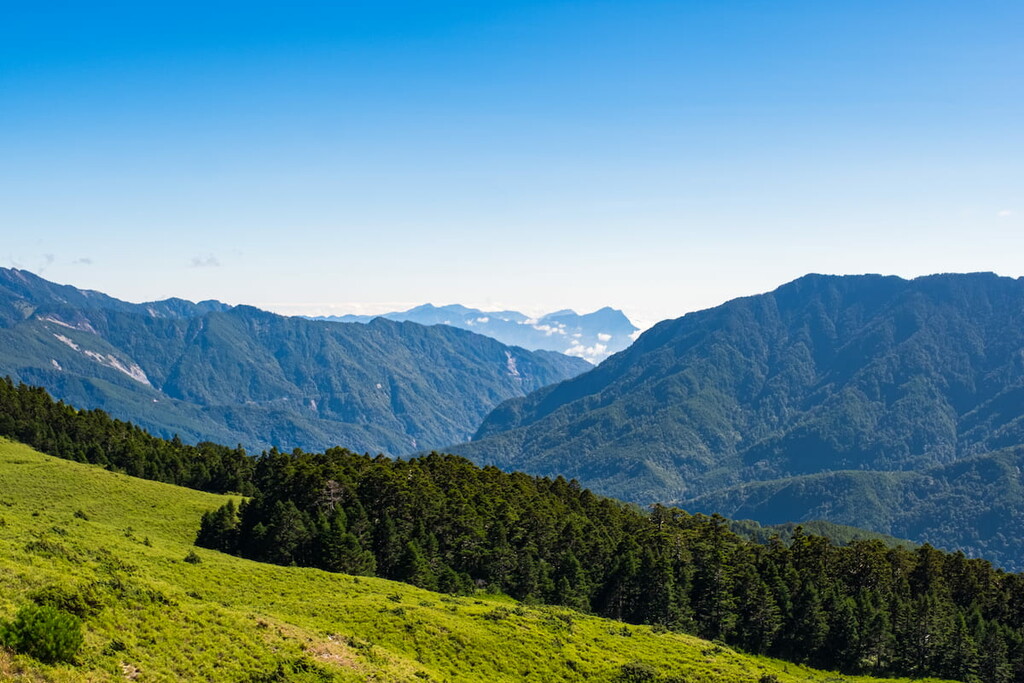
Basianshan National Forest Recreation Area is one of the three largest of Taiwan’s past logging bases alongside Alishan (阿里山國家森林遊樂區) and Taipingshan (太平山國家森林遊樂區). These densely sheltered woods held countless coniferous trees that were felled to produce essential oils and timber.
Considered one of the eight scenic spots in Taiwan, Basianshan National Forest Recreation Area is located in the Heping District (和平區) of Taichung City (臺中市). It covers a total area of 2,400 ha (5,930 ft), making it the second-largest logging base after Taipingshan.
A density of emerald broad-leaved jungle dominates the mid-elevations of Basianshan between 750 to 2,986 ,eters (2,461 to 9,797 ft) above sea level. Due to the overgrown lush forests that are found in the region, the sun hardly penetrates the forest canopy. For this reason, the area experiences an annual average temperature that’s a cool 64°F (18°C).
Two rivers flow through Basianshan National Forest Recreation Area: the Shiwen and the Jiabau, which are tributaries of the Dajia River. These two streams flow at full capacity and contain enriched mineral water of the purest quality.
Basianshan was a name bestowed by the Japanese during the logging era. The peak of Basianshan (八仙山) measure 8,000 feet (2,438 metres); thus, Japanese officials initially named the mountain Baqianshan (八千山) after its height. The Japanese then granted the more elegant and similar sounding name of Basianshan, which means ‘eight immortal mountains,’ to the peak.
The other hills in Basianshan National Forest Recreation Area are:
Taiwan’s second tallest mountain, Xueshan (雪山), sits to the north of Basianshan National Forest Recreation Area in Shei-Pa National Park (雪霸國家公園). To the east is Hehuanshan (合歡山) of Taroko National Park (太魯閣國家公園). Meanwhile, Huisan Forest (蕙蓀林場) lies to the south, with Dakeng Scenic Area (大坑風景區) of Taichung City to the west.
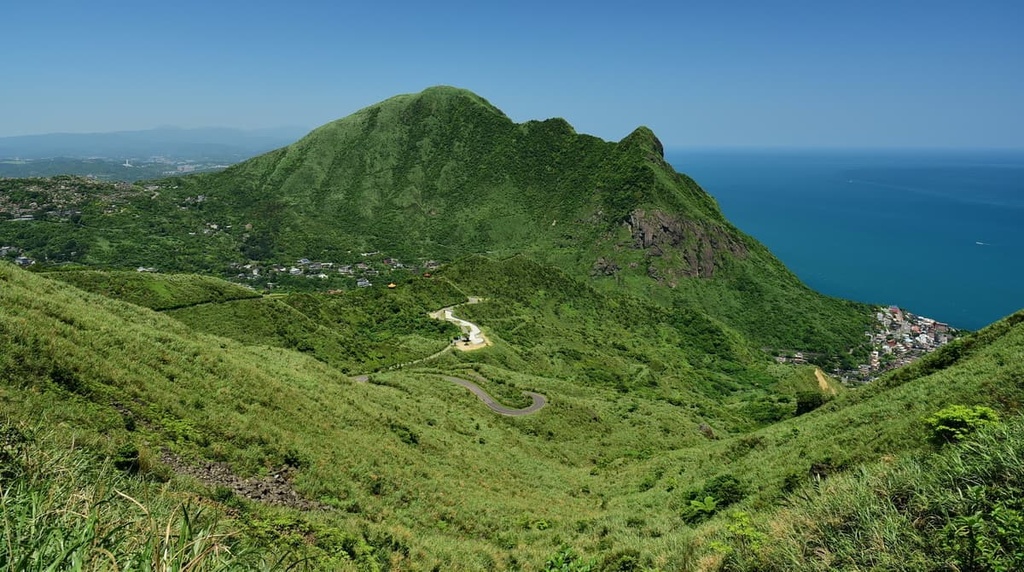
The hills of Basianshan National Forest Recreation Area form an extension of Taiwan’s second-largest massif, the Xueshan Range (雪山山脈), to the south.
Consisting of 1,233 named peaks, the Xueshan Range is home to 18 of Taiwan’s top 100 mountains, the tallest of which is Xueshan at 3,886 meters (12,749 ft). In addition, Xueshan Range spans a length of 260 km (161 mi) and it has a width of 28 km (17 mi).
Basianshan’s mountains’ rock strata date back between the Eocene to the Oligocene epochs. The rock bed consists of sandy shale, interlaced with clay, slate and hard sandstone.
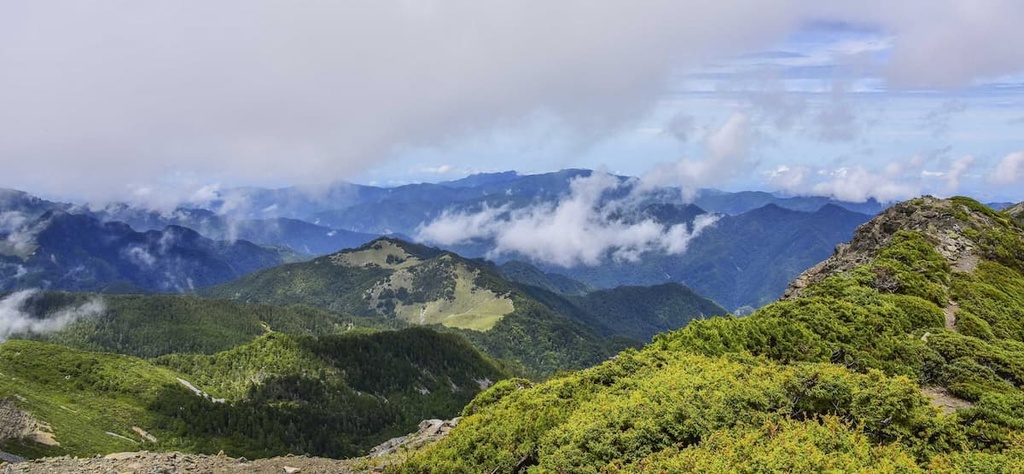
In the lower elevations of Basianshan National Forest Recreation Area, the primary vegetation is an evergreen broad-leaved forest. Plant species such as the tung tree, ferns, and star orchids are the distinct plant communities in this forest belt.
From 1,800 metres (5,905 ft) above sea level, several giant Taiwan cypress and Taiwan red cypress trees signal the mix of coniferous trees with the broad-leaved forest. Taiwan five-leaf pine, Taiwan fir, and Japanese cedar comprise other coniferous trees of the mixed forest.
The mountainous area is abundant in overgrown, wild forests, creating an appropriate habitat for many birds. The common birds of the 68 species spotted in the forest are the Taiwanese blue magpie, the red-billed black bulbul, and the great crested eagle. In addition, a total of 72 kinds of butterflies are found in the forest, such as the swallowtail butterfly.
Many years ago, Basianshan's green forest areas were bursting with Taiwan cypress trees, which interested the likes of Japanese forestry officials during the Japanese Occupation Era. At this time, the Atayal Tribe lived primarily in the hills of Basianshan.
As the Japanese wanted no interference in the mountains, they banished the Atayal people from their homelands and forced them to live in policed areas at lower elevations. With the removal of the Atayal tribe, the Japanese could carry out operations of logging timber.
Thus, Basianshan's logging base began in 1914 when logging operations commenced in the mountain's woodlands. Basianshan’s logging industry passed from the Japanese hands after the Second World War when Taiwan reclaimed it.
Situated above the visitor's center in Basianshan is a stone tablet declaring the Basianshan forests as one of Taiwan's top eight scenic spots. A torii gate serves as a stark reminder of the past by memorialising those who died while working at Basianshan's logging base.
The Japanese first erected a shrine to respect the fallen workers; however, a forest fire destroyed it. A pavilion was built in place of the shrine, yet destruction ravaged this memorial during the earthquake in 1988.
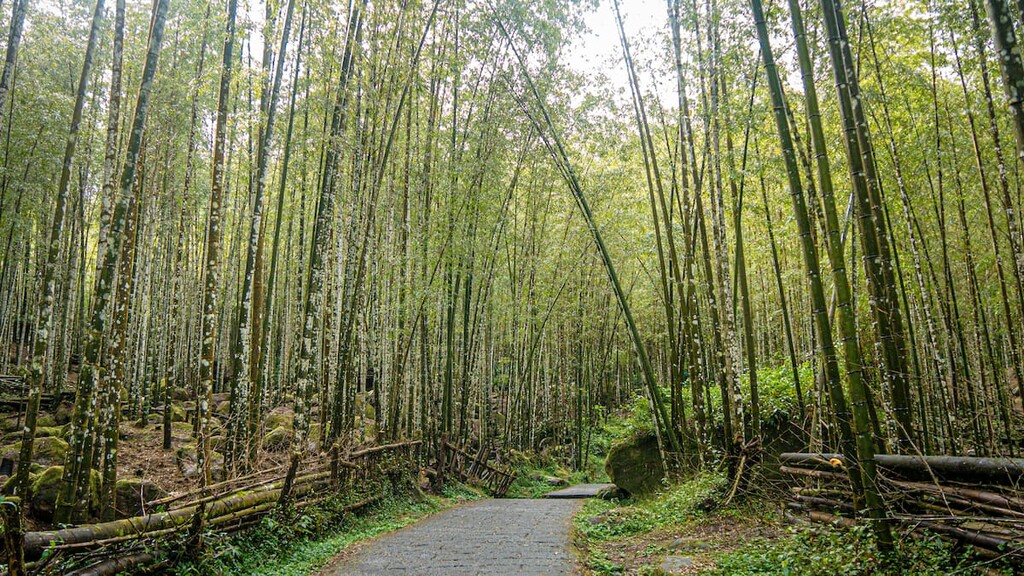
The logging business of Basianshan thrived for 49 years until 1963. By the time the logging ceased, a total area of 3,622 ha (8,950 ac) had been felled. producing a whopping collective of 1,150,233 cubic metres (40,620,095 cubic ft) of timber.
Taiwan forestry officials established the Basianshan National Forest Recreation Area in 1970 to protect the natural flourishing woods of this fertile region.
A trip to Basianshan National Forest Recreation Area features an abundance of sheltered woodlands of the ecologically rich environment. Furthermore, many short and leisurely mountain trails showcase the pristine river valleys and jagged landscape surrounding the Basianshan forest.
A journey to Basianshan involves trekking through a remote mixed broad-leaved and coniferous forest along a 6 km (3.7 mi) trail. The trail is intermediate in difficulty and it starts steeply before beginning to flatten out after the passing of the ridgeline.
The main attractions of hiking the Basianshan Hiking Trail are its historical prominence, the densely consuming ocean of woodlands, and the changing colours of the scenery. The elegant presence of cherry blossoms and the Paulownia fortunei add a delightful shade of soft pink flora to the path in spring.
On warm summer evenings, glittering sparks from fireflies ignite the humid skies. Ribbons of colour streak across the forest as butterflies gracefully flitter. As the forests lie in the fog cover belt, the forest humidity breeds a thick moss coating on the ground, boulders, and tree trunks.
After the fall of Basianshan’s logging base, railway tracks were stripped from the hillside ground. Hikers, therefore, cannot view the defunct railroad that once transported felled timber; however, the presence of telephone poles and piles of old logs tell a tale of the region’s logging history.
The first views from the trail commence after 700 meters (2,296 ft). The base of Basianshan overlooks the Jiabao River and Basianshan’s forest canopy.
Two trail stand on the track, offering the best views of Jilong Shan, Tung-Mao Shan (東卯山), Wuwowei Shan (屋我尾山), and Daxueshan (大雪山). On a clear, sunny day, the giant peaks of Yushan (玉山) and Qilai Shan (奇萊山) are also visible.
Forming the western extension of Baigu Dashan (白姑大山), Malun Shan’s mountain forest was once the hunting grounds of the Atayal. Malun Shan Hiking Trail covers the route of the old wooden horse trail that once led from Basianshan’s logging base to Xinshan Forest Farm.
Arguably one of the most scenic trails in Basianshan National Forest Recreation Area, the trek to Malun Shan spans a distance of 7 km (4.3 mi). A woven mass of pinecones clutters the springy mound of the soft forest floor.
Taiwan five-leaf pine and Japanese maple collectively feature in the woodlands. In autumn, the maple’s golden transformation creates a stirring sight, as the leaves gradually turn a deep burgundy, complementing the jade green forests.
The Malun Shan Hiking Trail is home to eight giant Taiwan pine trees standing on the slope near the trailhead. Further along the route lies the legendary ‘Five-leaf Pine Mother’ with a hefty circumference of 1 meter (3.2 ft). The Atayal tribe named this 100-year-old pine tree revered for its size and luck at escaping felling.
Along the trail, hikers can observe the many historical artefacts that serve as reminders of the logging industry. Old logging buildings that were once used as offices stand abandoned yet intact.
The viewing platform before the summit offers the best views from Malun Shan. Hikers can note the Dajia River Valley and the peaks of Hengling Shan (橫嶺山), Shaolai Shan (稍來山), and Wuwowei Shan from the platform.
When visitors enter the Basianshan National Forest Recreation Area, numerous trails lead through the verdant woodlands, highlighting a specific plant or animal specimen. Thus, the Bamboo Forest Trail, one of the most favoured trails in Basianshan forest, features a giant thicket of tall Moso bamboo shoots.
Hikers enter an emerald paradise of thin jade timber foliage that features soft lighting from the basking sunlight illuminating through gaps in the forest canopy. Otherworldly in appearance, Moso bamboo also creates satisfying sounds, especially when the soft mountain breeze whistles its path through the reedy bamboo sheets.
Utterly magical and eerily quiet, the graceful presence of butterflies gliding across the green sea of bamboo shoots adds a delightful charm as you hike. As with all the forest trails of Basianshan, the Bamboo Forest Trail is a short hike, and visitors of all ages and fitness levels can enjoy the absolute wonderment of this dense bamboo forest.
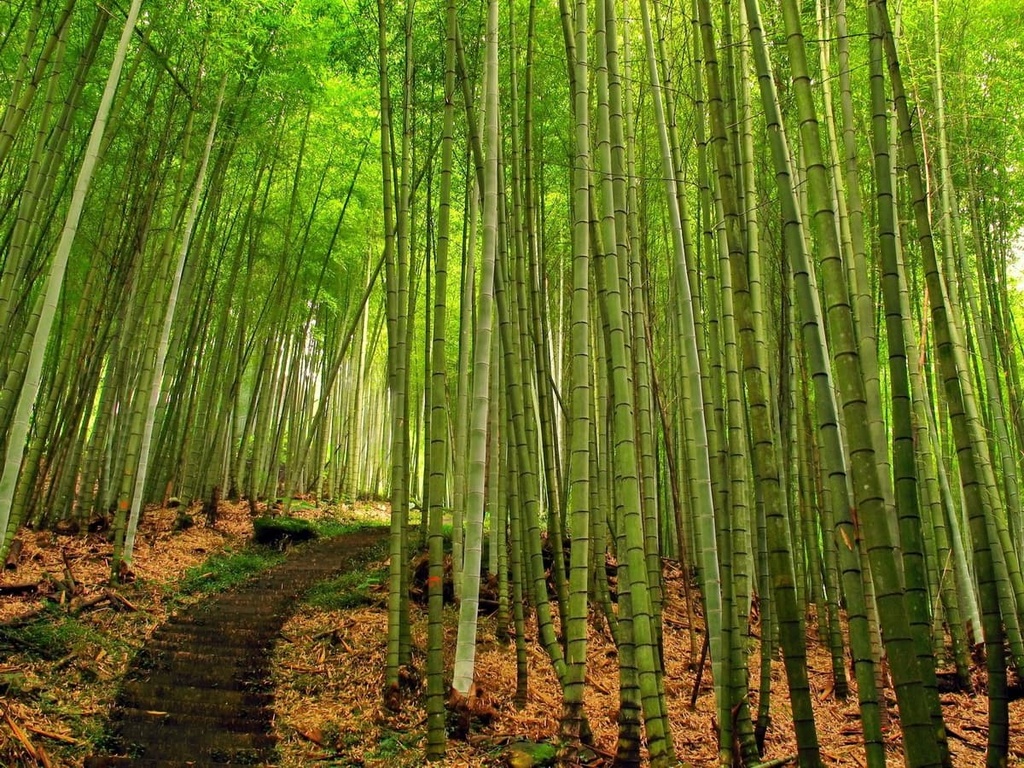
Situated alongside the Bamboo Forest Trail is the serene spectacle of the Cherry Blossom Forest Trail. Clusters of Taiwan mountain cherry trees that unfurl their blossoms in cold weather infiltrate the woods. Thus, between the chilly months of January and February, the pale pink cherry blossoms speckled with a hue of crimson bloom.
Although the Cherry Blossom Forest Trail blooms for two months of the year, the short trail is still a delight to wander, as the luscious foliage of the evergreen cherry tree is magnificently captivating. For those seeking the rejuvenating experience of a forest hike, the Cherry Blossom Forest Trail is an absolute must.
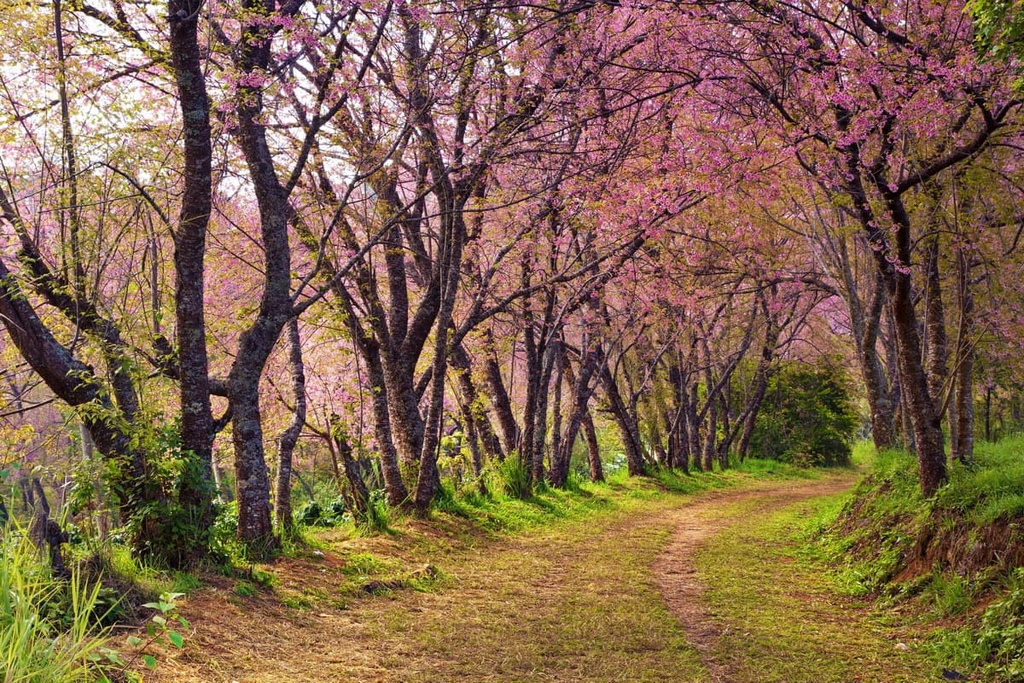
The short 1.7 km (1 mi) Jiabaotai Shan Hiking Trail leads hikers from the Jiabao Temple to the moderate hill of Jiabaotai Shan. Jiabaotai Shan is the northern extension of Basianshan and measures 1,406 metres (4,613 ft).
While the summit of Jiabaotai Shan is overgrown with tall silvergrass (Miscanthus sinensis) that blocks the view, there are clearings of rampant woodlands for hikers to admire. Hikers can overlook the pristine Shiwen River Valley, admiring the snaking sapphire creek winding its course along an evergreen embankment of lush foliage. In addition, hikers can note Daxueshan from the nearby Shei-Pa National Park along the path.
One of the highlights of this trail is the mentally stimulating effects of a forest bath. The thriving woodlands impregnate the air with the calming chemicals of phytoncide. In addition to this, the clearwater Shiwen River combined with the nearby verdant woods creates air vitamins in the form of negative ions. A refreshing dip in a forest bath calms both the body and mind, releasing stress hormones and lowering blood pressure.
The prominent feature of the Tianlai Hiking Trail is a 300-metre (984 ft) wooden boardwalk that leads to the Tianlai Platform. The trail traces the Shiwen River path with its rumbling aquamarine waters flowing against the mountainside.
Known for its harmonious resonance, the Tianlai Hiking Trail is also known as the Celestial Sounds Hiking Trail. The bubbling river, soft rustling of the breeze, and the melodic bird song that echoes in the vast coppice create an idyllic soundtrack of nature.
The Tianlai Hiking Trail ends at the starting point of the Basianshan Hiking Trail. The entire track spans 600 metres (1,968 ft), with hikers ending the trail at Jinghai Temple. The last 300 metres (984 ft) of the course starts to ascend sharply as hikers leave the river valley and climb wooden stairs.
Cradled in the luscious Dajia River Valley at an elevation of 800 metres (2,625 ft) is the Guguan Hot Springs (谷關溫泉). A forest of Taiwan five-leaf pine swarms the landscape with Basianshan featuring in the background.
The Atayal people discovered the thermal springs in 1907; however, the Japanese monopolised the area by building a public path. The misty hot spring valley was fit for royalty as members of the Japanese monarchy visited Guguan Hot Springs during the Japanese Occupation Era.
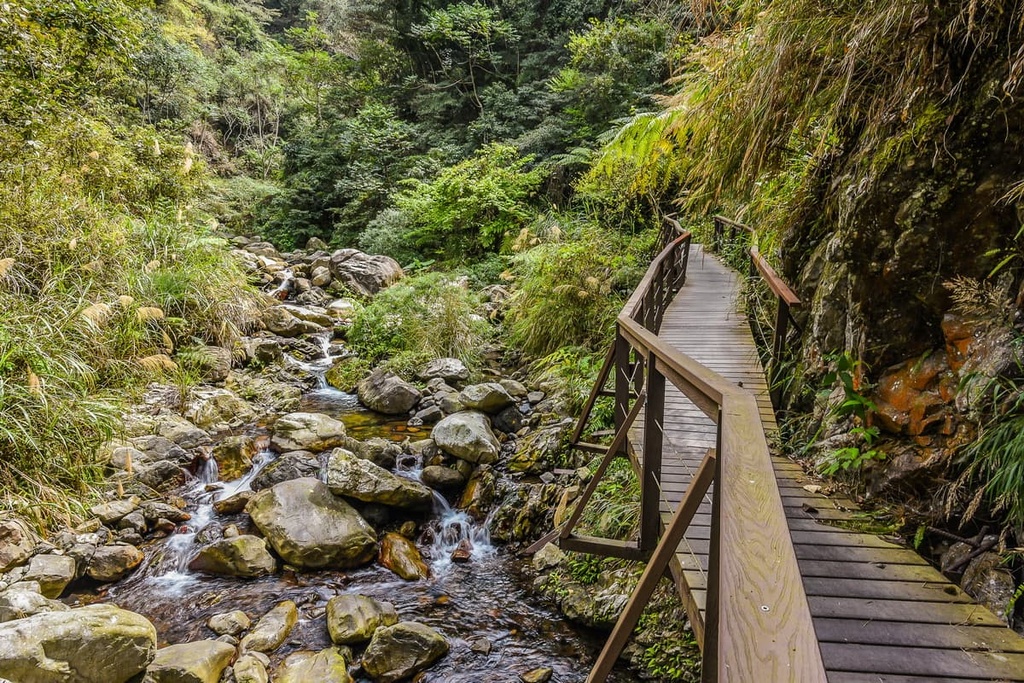
The thermal springs contain the minerals of carbonic acid and simmer at the temperature of 118°F (48°C). Spring and autumn are the most scenic months to visit, as the scenery is dominated either by pastel cherry blossoms or burgundy maple leaves.
According to legend, the hot spring waters contain a secret quality that assists women in conceiving a son. Emperor Meiji of Japan visited the Guguan Hot Springs, soaking in the bubbling thermal waters. Soon after, his wife was expecting a son, which led to the hot spring being dubbed ‘The Son Hot Spring.’
Legends aside, the hot springs mineral qualities are said to offer medical relief as many believe they soothe skin irritations and acs as a therapeutic agent for arthritis and nerve pain.
Taichung City is the closest metropolitan hub to Basianshan National Forest Recreation Area. Visitors could also stay in the rugged and verdant area of Heping District, which is located close to many trails of Basianshan forest and the surrounding areas.
Taiwan’s third-largest city, Taichung, offers a bustling metropolis without the population density of Taipei (臺北市) or Kaohsiung (高雄市). Very easy on the eyes, Taichung is a splendid mix of modern skyscrapers, charming historical tea houses, vibrant temples, and the thriving greenery of nature.
Undoubtedly one of the most striking and multi-coloured paintworks to grace a building’s exterior, the Rainbow Village is a renovated and lively space that once was a rundown military residence. The brilliance behind the revamp, Huang Yung-Fu, decided to add a fresh breath of life (and a fresh coat of paint) to the dilapidated and discarded old military quarters.

Understandably so, the Rainbow Village is hugely popular with tourists and locals alike, whose spirits instantly are lifted while wandering through the happy and radiant site.
Located in the Xinshe District (新社區) of Taichung City, the annual event of the Xinshe Sea of Flowers attracts tourists far and wide. In November and December, a fragrant blanket of bulbs erupts in colours of deep violets, creamy whites, sunny yellows, and radiant reds.
Flower lovers will appreciate the expansive sea of blooms stretching across the dreamy 60 ha (148 acre) area.
Taichung Liuchuan Canal Waterfront is Taichung’s answer to Seoul’s Cheonggyecheon. Completely paved on either side, the Liuchuan River runs through the heart of Taichung and is now pedestrianized for people to wander and observe the gently flowing water. The area is exceptionally stunning at nighttime, as blue lights shine onto the Liuchuan Canal, illuminating the walkway and the river in a nighttime calm.
Known for its divine beauty, the Taichung Park is a 20 ha (49 acre) space that features two pavilions overlooking an artificial lake and a gently arched bridge. A thicket of the interlinked upward rooted banyan trees add much-needed shade and a charming presence around the lake. One of the stately pavilions was built by the Japanese in 1900, who constructed the showpiece to amaze a Japanese prince visiting the city.
For visitors wishing to hike near Taichung City, the trails of Dakeng Scenic Area are the answer. A total of ten trails span the hilly terrain of silvergrass and tropical orchards. Along the hike, the vistas are superb and they include an endless view of flourishing mountain forests and a continuous view of rugged ridgelines of Dakeng Shan (大坑山).
Heping District is the base of many forested regions and mountainous areas, offering the unrivalled nature of rugged terrain, pristine virgin forests, delicate mountain flowers, and a cloak of mountain mist.
Situated southeast in Shei-Pa National Park is the most accessible area of Wuling Farm (武陵農場). In 1963, retired KMT fighters established the hilly fields of Wuling as an orchard. Wuling Farm is a picture of romance in springtime, as the soft dreamy pinks and full cream whites of cherry, plum, and peach blossoms begin to bloom. Furthermore, visitors are afforded the freshest variety of fruits at Wuling Farm, such as apples, pears, and peaches.
Daxueshan National Forest Recreation Area (大雪山國家森林遊樂區), which also fpr,s part of Shei-Pa National Park, sits at an elevation of 2,000 metres (6,562 ft). The dense woodlands feature a mixed coniferous-broadleaved forest, while in the upper elevations, the hardwood species of Taiwan hemlock, Taiwan five-leaf pine, and Taiwan red cypress feature.
In the region between Shei-Pa National Park and Taroko National Park lies the Lishan Scenic Area (梨山風景區) at an elevation of 2,000 metres (6,562ft). Lishan is revered for its impeccable mountain scenery. The mountain mists nurture the refreshing sweet fruit orchards of apples, pears, and peaches in the high hills.

Between the mammoth hills of Hehuanshan and Xueshan lies Fushou Shan Farm (福壽山農場), which ranges between 1,800 to 2,500 metres (5,905 to 8,202 ft). The Taiwan government gave this high mountain farming area to retired soldiers to develop a thriving farm.
As with the other scenic locations in Heping District, Fushou Shan Farm boasts a distinct four seasons. A mesmerising sea of clouds gracefully glides in the rolling landscape in the late afternoon, while visitors can admire the serene views of the luscious valleys and surrounding mountain scenery.
Visitors can take the Taiwan High-Speed Rail or the local express train from any of the major cities of Taiwan to Taichung City. Once there, they can hire a car and scooter and drive the 52 km (33 mi) journey to Basianshan National Forest Recreation Area.
There is one public transport option available to those not wishing to drive. From Taichung City High-Speed Rail Station, take the frequent Fongyuan 153 bus to Guguan. Visitors then change to the 269 bus in Guguan headed to Basianshan National Forest Recreation Area.
This bus only operates twice a day on weekends, so plan in advance. Alternatively, visitors can stay on the Fongyuan 153 bus until Duming Bridge and walk 3km (1.8 mi) to the Basianshan Visitors Centre.

Explore Basianshan National Forest Recreation Area with the PeakVisor 3D Map and identify its summits.








